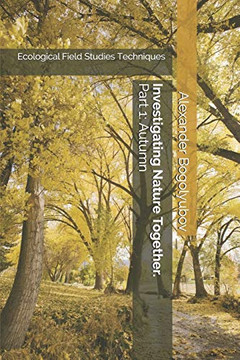This book contains ecological field studies techniques, that can be conducted in wild nature by non-professional researchers - school and university students together with their teachers, single beginning investigators, families, amateurs of all ages.The whole book "Field Studies Techniques" includes 5 parts/series corresponding to a specific field sciences (Geography, Botany, Zoology, Hydrobiology and Bioindication) with totally 40 environmental study lessons (see below) covered a wide variety of activities in nature which can be arranged in different seasons of the year. Each series contains techniques focusing on practical skills which can be applied in the field research.This book promotes a wide variety of outcomes which correspond to established educational standards in many countries. The ecological field study activities address content standards in the areas of earth science, life science, biology and ecology. Intellectual skill development includes questioning, data collection, analysis and drawing conclusions.This book is addressed to the middle and secondary level science teachers and students, and for all those who would like to investigate local wild nature, to share ecological and cultural information and work together to help create a better environment.This specific book "Field Studies Techniques. Part 1: Geography and Landscape Sciences" is the first in the series. Practical skills emphasize orienteering on the study area, simple eye survey (mapping) with compass and lessons focus on geology, soil and relief, as well as hydrology studies of small streams and snow cover. These activities are the basis of future field work.The techniques described in this book, were written by Alexander Bogolyubov (1996-2002), translated into English by Tatiana Tatarinova (2002) and edited by Michael Brody (2003).The list of all field study lessons: I. Geography & Landscape Sciences (this book): Orienteering in the forest Simple "Eye" Survey of the Field Study Site Mapping Forest Vegetation Procedure of the Geological Exposure Description Studying Minerals and Rocks in Your Area Plotting a Profile of a River Valley Slope Simple Procedure of Soil Description Integrated Study Based on Landscape Profile Study of Snow Cover Profile Making a Campfire Botany: Study of Species Composition and Number of Fungi Making a Herbarium The Study of Plants in Your Local Environment Study of the Vertical Structure of a Forest Mapping Forest Vegetation Green Plants Under Snow Study of the Ecology of Early Flowering Plants Phenology of Plant Florescence Study of Growth Dynamics of Trees Based on Annual Rings Zoology: Study of Forest Invertebrates in the Forest Litter and Wood Study of Forest Invertebrates in the Grass Layer, Tree Crowns and Air Studies of Species Composition and Abundance of Amphibians Let's Help Birds! Making Feeders and Nesting Boxes Study of Species Composition and Census of Birds Using the Line Transect-counting Method Studies of Bird Populations Size by Different Methods Studies of the Day Activity of Singing Birds Study of Birds' Nesting Life Methods of Observation of a Chickadee Flock's Territorial Behavior Procedure of Winter Mammals Route Census by Footprints Study of Mammal Ecology According to Their Tracks Hydrobiology & Water Ecology: Complex Comparative Description of Small Rivers and Streams Physical and Chemical Properties of Natural Waters The Study of Water Invertebrates in a Local River and Assessment of Its Environmental State Study of PlanktonStudy of Fauna of Spring Temporary Water Bodies Bioindication Assessment of Air Pollution by Lichen Indication Method Assessment of the Vital State of a Forest Based on Pine-tree Analysis Assessment of Ecological Features of Meadows on the Base of Vegetation Cover Assessment of Environmental State of the Forest Based on Leaves' Asymmetry Assessment of the Vital State of Coniferous Underbrush
| Author: Dr. Alexander Bogolyubov |
| Publisher: Independently published |
| Publication Date: January 07, 2020 |
| Number of Pages: 224 pages |
| Language: English |
| Binding: Paperback |
| ISBN-10: 1657116182 |
| ISBN-13: 9781657116184 |

